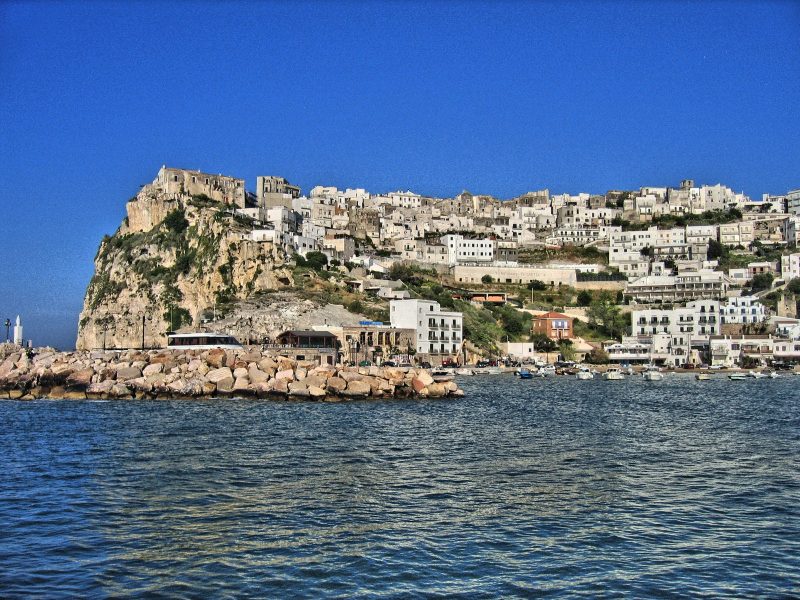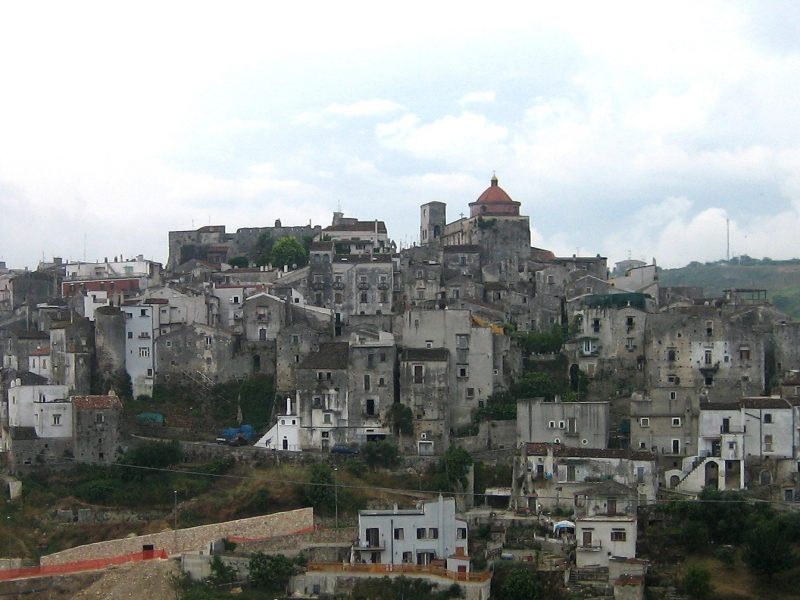The Borgo of Monte Sant'Angelo
Monte Sant’Angelo is a fascinating borgo at the top of the world, nestled at the tip of a rocky mountain overlooking the sea: one of those tiny mountain borgos that jealously protects its traditions, beliefs and cultural heritage. Over time, the walls of its Norman Castle have been absorbed into the daily life of the inhabitants, majestically protecting the delightful historical center of white-washed houses and ancient stone streets.
Monte Sant’Angelo is enveloped in a veil of authentic faith, custodian of an archaic Christianity, made of whispered chants, frankincense and myrrh. The streets of this mythical borgo are still frequented by the pilgrims who have been coming here since Medieval times to worship at the altar of San Michele, St. Michael, offering their eternal devotion. Not far from the sacred Cavern of St Michael the Archangel is the Church of San Pietro and the “Battistery di San Giovanni” (St. John the Baptist), ancient places of worship that have silently born witness to this continual pilgrimage over the centuries, their mystical beauty only partially ravaged by time.
Regardless of ones faith, at least once in a lifetime we should embark on a pilgrimage, a quest in search of who we are, and in this sacred mountain hermitage, you will surely find what you are looking for.
History
The origins of Monte Sant’Angelo are lost somewhere between legend and myth, interwoven with Medieval culture and archaic spirituality.
In long ago 490 A.D., in the area that would become Sant’Angelo, a wealthy shepherd lost his bull, and after two days of exhaustive search, finally found him, kneeling in a narrow cave. He was so fond of the animal that, even though it was evident that he wouldn’t be able to fit into the entrance, he tried everything he could to save him. All his attempts were in vain, and finally, in desperation, he shot an arrow at the bull, but the arrow inexplicably came back toward him. Not knowing what else to do, the shepherd went and explained everything to the Bishop of Siponto, who ordered the population to perform three days of penitence. On the third day, the 8th of May to be exact, St Michael the Archangel appeared to the Bishop and asked him to consecrate the cave in the Christian faith in his name. In the years to come, the Archangel manifested himself before the Bishop on two more occasions, in 492 and 493 A.D.
And so began the foundation of an urban center, officially recognized in the heart of the Medieval period, the year 1000.
The legend of St. Michael, or San Michele, brought such fame to this borgo that it still draws people today. All through the centuries it has been a heavily trafficked pilgrimage destination along the pilgrimage route of what is known as the “Via Francigena”. This route begins at the Sanctuary of Mont Saint Michel in Normandy and reaches the furthest tip of Italy at the Sanctuary of Santa Maria di Leuca.
Despite the aura of sacredness surrounding this borgo, Monte Sant’Angelo was not spared the brutality of Saracen Turk invasions or an epidemic of the Plague, which decimated the population in 1656. On that occasion, it is said that the Archangel San Michele manifested himself again to the presiding bishop, dispensing grace and healing powers.
In 1700, Monte Sant’Angelo began to expand its urban confines with new constructions that modified the ancient urban plan, creating new quarters outside the city walls.
Monte Sant’Angelo is not only a center of Christian spirituality. In 2011, this borgo became a UNESCO World Heritage site, and in 2014, the National Geographic Society included the cave of San Michele as one of the ten most beautiful in the world.
Grotta di San Michele Arcangelo, the Cave of St. Michael the Archangel
Since the V century A.D., when several apparitions of the St. Michael the Archangel were reported to have occurred, Monte Sant’Angelo has become a favorite destination for pilgrims, who travel from far and wide to be here. Often they arrive from across the Alps, coming from the monastery of Mont Saint Michel, following the pilgrimage route of the “Via Francigena”. The Crusaders, on their way to the Holy Land, considered this place to be an obligatory stop to purify themselves before their grand endeavor. This sanctuary has hosted popes and saints, including St. Francis of Assisi.
In the Christian tradition, it is said that the cardinals who come to visit the Cave of St. Michael are destined to become Pope: and so it was for Cardinal Karol Woijtila, who passed by here in 1974, and also for other important names who took the Papal seat.
The Cave of St. Michael is no longer the rustic place of Medieval pilgrimages, where those who came to venerate the saint had to make their way down precarious steps carved out of the rocky walls. Today, visitors are welcomed by a little church, perfectly wedged in to the subterranean cave. Once you descend the eighty-nine steps, you will arrive at the small outer atrium which leads to the “Porte di Bronze” (the Doors of Bronze), crafted in Constantinople and donated to the church by a merchant from Amalfi, incised with scenes depicting the lives of various saints. These doors open onto a simple and austere little church constructed in the Gothic style. On the right side of the church you find the entrance to the Cave of St. Michael, “La Grotta di San Michele”: a crypt carved in the rock, illuminated by a few candles and the daylight that filters in through a narrow crack in the wall of the cave. The only decorations in the cave are altars: the Baroque altar dedicated to “Santissimo Sacramento” and the central altar supporting the statue of San Michele, which was sculpted in Carrara marble in 1507 by Andrea Cantucci, known as Sansovino.
Il Castello di Monte Sant’Angelo, the Castle of Monte Sant’Angelo
From the IX century on, the little community of Monte Sant Angelo was protected inside the walls of the borgo’s castle, which embraced and guarded the entire urban center. At the beginning of that century, fortified complexes of dwellings, known as castrum, were constructed by the Byzantines and also the Lombards, who were ardent worshipers of San Michele and therefore an influential presence in the Apulian borgo.
For ten centuries the Castle of Monte Sant’Angelo reigned over the borgo, hosting princes and princesses, the royal dynasties of Normans, Swabians, Angevins and Aragons; modifying itself to fit their needs and the changing fashion of the times.
Only one part of the original ancient nucleus has survived the passage of time, a pentagon-shaped tower known as “La Torre dei Giganti”, The Tower of Giants, which probably dates back to the Norman period, constructed over the ruins another defensive structure built by the Lombards.
The most important architectural modifications to the castle were made during the years of the empire of Federico II and later during the period of Aragon rule, which gave the castle the stylistic imprint we can still admire today.
After belonging the Grimaldi di Gerage family, the castle became royal domain in 1798, and remained so until the fall of Napoleone Bonaparte. With the return of the Bourbons, the castle was consigned to a Cardinal Ruffo who then donated it to his heirs. Unfortunately, the heirs made the disastrous mistake of abandoning it to the management of the local farmers and shepherds, who partially demolished it and transformed it into a shelter for their animals, causing irremediable damage.
Only in 1907 was the municipality of Monte Sant’Angelo finally able to free the castle from bureaucratic entanglements and carry out important restoration work on the structure, making it possible to be visited by the public.
The Museum of Traditional Arts and Culture of Gargano “Il museo di arti e tradizioni popolari del Gargano”.
The ex-Convent of San Francesco in Monte Sant’Angelo, has become one of the most important civic museums of traditional art and culture in Puglia.
This museum displays concrete examples of a civilization that, recent as it may be, we know very little about. The vast photographic archive, the ancient tools and utensils, and the historical reconstructions create an environment that invites you directly into the lives of the men and women who lived at the turn of the century, sharing their joys and tribulations as they face daily challenges that, today, no longer exist, even in our collective imaginations. You are taken you on a fascinating journey of through time, to discover the customs and traditions of our roots, and the curious events and stories of times long gone by.
The displays of the ancient, traditional crafts attract the curiosity of young and old alike, from the looms where fabric was produced, to the tools used to cultivate the wheat fields, from the production of wine to the traditional art of wood working.
This museum is an invaluable cultural testament, an engaging presentation of ancient traditions in an innovative format that continues to attract large numbers of visitors, especially the curious minds of the younger generation.
The Tomb of King Rotari?
In Monte Sant’Angelo there is a legend regarding an historically important ruler of 600’s, King Rotari of the Lombards, a legend which draws numerous visitors to this borgo in Gargano from all over Italy.
A few steps from the Sacred Cave of St. Michael the Archangel, there is a complex of monuments dedicated to St. Peter, San Pietro, which historical sources believe was constructed even before the Sanctuary itself. The complex includes the remains of the Church of San Pietro and a partially hidden structure which was probably a baptistery: the Baptistery of St. John.
Inside this building there is an epigraph, which was long thought to indicate that the Lombard sovereign, King Rotari, was buried there, given that in life he had expressed the desire to have his burial at Monte Sant’Angelo. Nonetheless, it is more probable that King Rotari still rests in Pavia, where he actually died, and that the basis of this popular belief is an incorrect interpretation of the term tumba incised in the interior of the Baptistery.
Legend aside, the complex of San Pietro is a fascinating place and merits a visit, with or without the King of the Lombards. What remains of the ancient church is a nave without a roof, an apse, and the baptistery, finely crafted by master sculptors. On the portal, the capitals, and cornices there are sculptural scenes from the Old and New Testament, and marvelous anthropomorphic figures which are probably allegorical representations of the vices and virtues of humanity.
Do you know famous people of this borgo? Contact us!
Le ostie piene (“Host”sweets)
Accidents are the mothers of invention, as the inhabitants of Monte Sant’Angelo well know. They remember it every time they go to the baker’s, or the pastry shop, or just walking down the street: the delicious scent of caramelized almonds floating by brings to mind one thing, the ostie chene, or “ostie piene”, the “Host” sweets. In this borgo, it is the sweetest sweet there is, made with toasted almonds caramelized with honey and sugar, enclosed in two “Hosts”, like the ones used by priests in the Holy Sacrament. As you walk the magical streets of Monte Sant’Angelo, you will come across numerous variations of this specialty pastry which the local shops display with pride.
The invention of the “ostie piene” was purely by chance: the story goes that in the Convent of the Trinity, the “Monache Clarisse” (the nuns of St. Claire) liked to prepare caramelized almonds. One day, some of the “hosts” fell onto the sticky almond confection by mistake, and try as they might, they couldn’t separate one from the other, not even when they added another oval of the “host” on top. The result? One of the most delicious “mistakes” of all time!

 Italiano
Italiano
 Deutsch
Deutsch

















